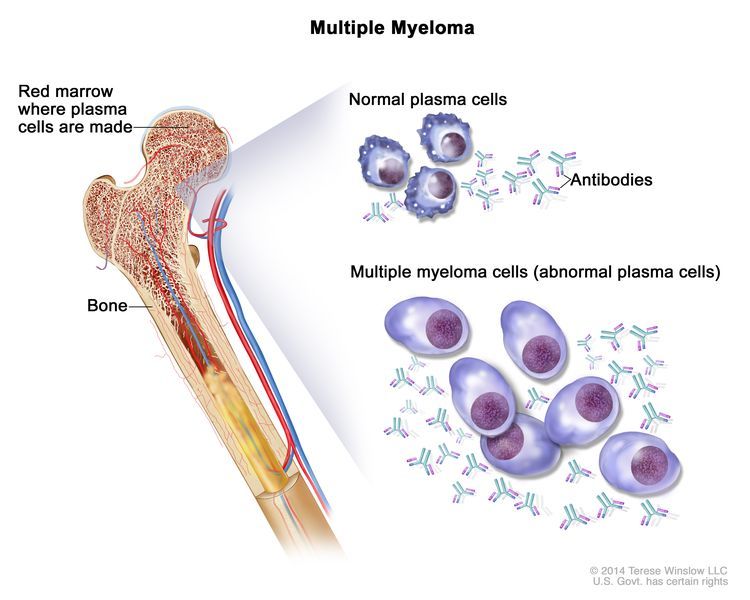Plasma cell neoplasms
Plasma cell neoplasms

General Information About Plasma Cell Neoplasms
KEY POINTS
- Plasma cell neoplasms are diseases in which the body makes too many plasma cells.
- Plasma cell neoplasms can be benign (not cancer) or malignant (cancer).
- There are several types of plasma cell neoplasms.
- Monoclonal gammopathy of undetermined significance (MGUS)
- Plasmacytoma
- Multiple myeloma
- Multiple myeloma and other plasma cell neoplasms may cause a condition called amyloidosis.
- Age can affect the risk of plasma cell neoplasms.
- Tests that examine the blood, bone marrow, and urine are used to diagnose multiple myeloma and other plasma cell neoplasms.
- Certain factors affect prognosis (chance of recovery) and treatment options.
Plasma cell neoplasms are diseases in which abnormal plasma cells or cells form tumors in the bones or soft tissues of the body. The plasma cells also make an antibody protein, called M protein, that is not needed by the body and does not help fight infection. These antibody proteins build up in the bone marrow and can cause the blood to thicken or can damage the kidneys.
Plasma cell neoplasms can be benign (not cancer) or malignant (cancer).
Monoclonal gammopathy of undetermined significance (MGUS) is not cancer but can become cancer. The following types of plasma cell neoplasms are cancer:
- Lymphoplasmacytic lymphoma (also called Waldenström macroglobulinemia).
- Plasmacytoma.
- Multiple myeloma.
There are several types of plasma cell neoplasms.
Plasma cell neoplasms include the following:
Monoclonal gammopathy of undetermined significance (MGUS)
In this type of plasma cell neoplasm, less than 10% of the bone marrow is made up of abnormal plasma cells and there is no cancer. The abnormal plasma cells make M protein, which is sometimes found during a routine blood or urine test. In most patients, the amount of M protein stays the same and there are no signs, symptoms, or health problems.
In some patients, MGUS may later become a more serious condition, such as amyloidosis, or cause problems with the kidneys, heart, or nerves. MGUS can also become cancer, such as multiple myeloma, lymphoplasmacytic lymphoma, or chronic lymphocytic leukemia.
Plasmacytoma
In this type of plasma cell neoplasm, the abnormal plasma cells (myeloma cells) are in one place and form one tumor, called a plasmacytoma. Sometimes plasmacytoma can be cured. There are two types of plasmacytoma.
- In isolated plasmacytoma of bone, one plasma cell tumor is found in the bone, less than 10% of the bone marrow is made up of plasma cells, and there are no other signs of cancer. Plasmacytoma of the bone often becomes multiple myeloma.
- In extramedullary plasmacytoma, one plasma cell tumor is found in soft tissue but not in the bone or the bone marrow. Extramedullary plasmacytomas commonly form in tissues of the throat, tonsil, and paranasal sinuses.
Signs and symptoms depend on where the tumor is.
- In bone, the plasmacytoma may cause pain or broken bones.
- In soft tissue, the tumor may press on nearby areas and cause pain or other problems. For example, a plasmacytoma in the throat can make it hard to swallow.
Multiple myeloma
In multiple myeloma, abnormal plasma cells (myeloma cells) build up in the bone marrow and form tumors in many bones of the body. These tumors may keep the bone marrow from making enough healthy blood cells. Normally, the bone marrow makes stem cells (immature cells) that become three types of mature blood cells:
- Red blood cells that carry oxygen and other substances to all tissues of the body.
- White blood cells that fight infection and disease.
- Platelets that form blood clots to help prevent bleeding.
As the number of myeloma cells increases, fewer red blood cells, white blood cells, and platelets are made. The myeloma cells also damage and weaken the bone.
Sometimes multiple myeloma does not cause any signs or symptoms. This is called smoldering multiple myeloma. It may be found when a blood or urine test is done for another condition. Signs and symptoms may be caused by multiple myeloma or other conditions. Check with your doctor if you have any of the following:
- Bone pain, especially in the back or ribs.
- Bones that break easily.
- Fever for no known reason or frequent infections.
- Easy bruising or bleeding.
- Trouble breathing.
- Weakness of the arms or legs.
- Feeling very tired.
A tumor can damage the bone and cause hypercalcemia (too much calcium in the blood). This can affect many organs in the body, including the kidneys, nerves, heart, muscles, and digestive tract, and cause serious health problems.
Hypercalcemia may cause the following signs and symptoms:
- Loss of appetite.
- Nausea or vomiting.
- Feeling thirsty.
- Frequent urination.
- Constipation.
- Feeling very tired.
- Muscle weakness.
- Restlessness.
- Confusion or trouble thinking.
Multiple myeloma and other plasma cell neoplasms may cause a condition called amyloidosis.
In rare cases, multiple myeloma can cause peripheral nerves (nerves that are not in the brain or spinal cord) and organs to fail. This may be caused by a condition called amyloidosis. Antibody proteins build up and stick together in peripheral nerves and organs, such as the kidney and heart. This can cause the nerves and organs to become stiff and unable to work the way they should.
Amyloidosis may cause the following signs and symptoms:
- Feeling very tired.
- Purple spots on the skin.
- Enlarged tongue.
- Diarrhea.
- Swelling caused by fluid in your body's tissues.
- Tingling or numbness in your legs and feet.
Age can affect the risk of plasma cell neoplasms.
Anything that increases your risk of getting a disease is called a risk factor. Having a risk factor does not mean that you will get cancer; not having risk factors doesn't mean that you will not get cancer. Talk with your doctor if you think you may be at risk.
Plasma cell neoplasms are most common in people who are middle aged or older. For multiple myeloma and plasmacytoma, other risk factors include the following:
- Being Black.
- Being male.
- Having a personal history of MGUS or plasmacytoma.
- Being exposed to radiation or certain chemicals.
Studies about how racial, social, and financial factors affect access to treatment and rates of plasma cell neoplasms are ongoing.
Tests that examine the blood, bone marrow, and urine are used to diagnose multiple myeloma and other plasma cell neoplasms.
The following tests and procedures may be used:
- Physical exam and health history: An exam of the body to check general signs of health, including checking for signs of disease, such as lumps or anything else that seems unusual. A history of the patient’s health habits and past illnesses and treatments will also be taken.
- Blood and urine immunoglobulin studies: A procedure in which a blood or urine sample is checked to measure the amounts of certain antibodies (immunoglobulins). For multiple myeloma, beta-2-microglobulin, M protein, free light chains, and other proteins made by the myeloma cells are measured. A higher-than-normal amount of these substances can be a sign of disease.
- Bone marrow aspiration and biopsy: The removal of bone marrow, blood, and a small piece of bone by inserting a hollow needle into the hipbone or breastbone. A pathologist views the bone marrow, blood, and bone under a microscope to look for abnormal cells.
KEY POINTS:
- Waldenstrom macroglobulinemia (WM) is a lymphoplasmocytic malignancy characterized by the excessive production of monoclonal lgM antibody. Clinical manifestations of WM stem from elevated serum lgM (hyper viscosity syndrome, neuropathy, cryoglobulinemia) and neoplastic infiltration of tissue (hepatosplenomegaly, lymphadenopathy, cytopenia). Peripheral blood smear may show rouleaux formation (or erythrocyte agglutination) due to elevated serum protein. Serum protein electrophoresis (SPEP) is an important screening study; patients with WM have a monoclonal spike (M-spike) of IgM. Diagnosis is then confirmed by bone marrow biopsy showing >10% clonal B cells with specific cytogenetic features. The patient presents with manifestations of hyper viscosity syndrome (diplopia, tinnitus, headache, dilated/segmented funduscopic findings), neuropathy (electric sensation), and evidence of infillralive disease (hepatosplenomegaly, anemia, thrombocytopenia), suggesting WM.
- A minority of patients with chronic lymphocytic leukemia (CLL) have high levels of monoclonal lgM, However, patients with CLL tend to have a dramatic lymphocytic predominant leukocytosis (often >100,000/mm3) on complete blood count.
- Patients with monoclonal gammopathy of undetermined significance (MGUS) also have M spikes, but they are most commonly due to lgA, lgG, or lgD (lgM is seen in 15% of cases). MGUS is marked by smaller M spikes (<3 g/dL), bone marrow biopsy with <10% monoclonal plasma cells



